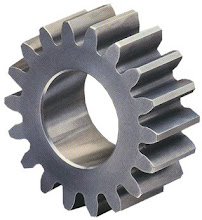Milling machine
From Wikipedia, the free encyclopedia

A milling machine is a machine tool used for the shaping of metal and other solid materials. Its basic form is that of a rotating cutter which rotates about the spindle axis (similar to a drill), and a table to which the workpiece is affixed. In contrast to drilling, where the drill is moved exclusively along its axis, the milling operation involves movement of the rotating cutter sideways as well as 'in and out'. The cutter and workpiece move relative to each other, generating a toolpath along which material is removed. The movement is precisely controlled, usually with slides and leadscrews or analogous technology. Often the movement is achieved by moving the table while the cutter rotates in one place, but regardless of how the parts of the machine slide, the result that matters is the relative motion between cutter and workpiece. Milling machines may be operated manually or by CNC (computer numerical control).
Milling machines can perform a vast number of operations, some of them with quite complex toolpaths, such as slot cutting, planing, drilling, diesinking, rebating, routing, etc.
Cutting fluid is often pumped to the cutting site to cool and lubricate the cut, and to sluice away the resulting swarf.











